Irvine by Erwin

Photo by Max Dolberg
Twin concrete buildings stand in the blazing Orange County sun at the corner of Campus and East Peltason drives. A white steel staircase zigzags between their four levels, lacing the structures together. They blend in with the modern architectural style of Southern California—functional, but hardly impressive.
A dark gray Toyota Prius—California license plate UCI Law 1—is parked out front. The windshield has a small, star-shaped crack on the passenger side that’s been there for some time. The gray, cloth interior could use a good detailing. The owner has had bigger things on his mind.
Erwin Chemerinsky—the sometime U.S. Supreme Court advocate and nation’s most-cited full-time legal academic—is eager to talk about his “next big thing”: an attempt to create the first top-tier American law school to be founded in more than 50 years. As if that weren’t an audacious enough goal, it’s designed to be among the most innovative law schools in the nation.
So far, it’s been a journey with both ups and downs, and one that almost ended before it began.
In 2007, in the space of a week, Chemerinsky was hired, then fired, by University of California at Irvine Chancellor Michael Drake.
Chemerinsky, then a constitutional law professor at Duke University, said it was because of his liberal political opinions, which are frequently on view in op-eds and the kinds of cases he litigates.
Drake denied politics played a part, or that he was pressured to dump the professor by leaders in conservative Orange County. But he did say, “We must ensure that our broader goals are not overshadowed by issues, personalities and polarization.”
After almost a month of headlines, including a New York Times op-ed supporting the professor, Chemerinsky was rehired.
Since then, he’s raided some of the country’s elite law schools for faculty, including sister school Boalt Hall at UC Berkeley and his former employer, Duke.
It’s a well-regarded group, ranking 10th in the nation in “scholarly impact,” based on the average number of times its members’ articles have been cited in law reviews, according to a study by the blog Brian Leiter’s Law School Reports.
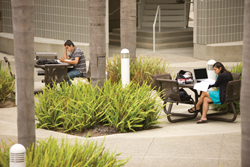
Photo by Max Dolberg
The initial funding proposal presented to Chemerinsky for the law school at UC Irvine was wildly under budget, he says.
“I would have had to take a 50 percent pay cut,” he says, “and the offered salaries of senior professors were less than the average for most starting professors.”
More money was appropriated by the university for the school’s operations, including full-tuition scholarships for its inaugural class of 65. That’s expected to cost the school $6 million over the course of its first three years. Still more cash was needed to gut the two existing buildings the school will occupy, creating tiered classrooms, better faculty offices and a reinforced floor system capable of supporting the weight of the library books necessary for ABA accreditation.
READY, SET …
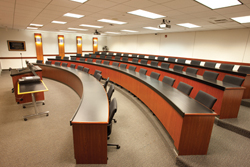
Photo by Max Dolberg
With its first class—which has a median GPA of 3.65 and a median LSAT score of 167—descending on campus this month, the 56-year-old Chemerinsky’s ambition is about to be put to the test. Can UC Irvine be both among the best law schools and among the most innovative?
If not, it will not be for lack of trying. “There isn’t a need for another law school that replicates the others that are there,” Chemerinsky says. “We have the wonderful benefit of a blank slate and the chance to create the ideal law school for the 21st century.”
UC Irvine will include an interdisciplinary curriculum and a mandatory semester in one of the planned eight law clinics. Students will be required to conduct intake interviews for legal aid clients and to study international law in the first year—a subject that is merely optional in the upper classes at most schools.
Another innovation is the course titled “The Legal Profession.” The two-semester class will bring in speakers from many areas of practice “so that students can gain a sense of the different kinds of work the profession does,” according to an online description of the curriculum.
Chemerinsky wants to maximize “serendipitous interaction with faculty and students.” That’s why lounge chairs sit outside the faculty offices, so the students don’t have to sit on the floor while waiting. The chairs are arranged in groups to encourage discussion.
Rocking chairs, modeled after one owned by librarian Beatrice Tice’s mother, will be placed near the library windows to promote serenity. Reproductions of paintings of SoCal scenery, copied from some on view in the Orange County Art Museum, will further the Zen vibe.
The innovations extend beyond the learning environment. Each student will be assigned a practicing lawyer as a mentor. Financial planners will be invited to campus to help students with budgeting and—for those in the second class and beyond—managing the burden of law school loans. Students will have multimedia portfolios to show potential employers, in addition to ordinary resumés. They’ll receive grades, but there will be no class rankings.
CHOOSING CHANCES
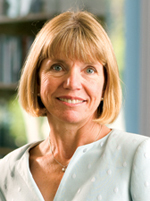
Catherine Fisk
Photo by Max Dolberg
A yearning for the nontraditional runs deep in both the stu- dent body and the faculty.
“It was much harder for the students who accepted our offer of admission to choose us by default,” says Victoria Ortiz, UC Irvine’s director of admissions. “To go to a brand-new school that is not yet accredited takes a leap of faith.”
Although more than 54 percent of law school applicants nationwide are under the age of 25, according to a recent Law School Admission Council report, UC Irvine’s mostly female class has an average age of 26. Ortiz says the inaugural class, which boasts documentary film makers, Peace Corps volunteers and founders of other institutions, is full of entrepreneurial risk-takers.
Jillian Cook, 21, a UC Berkeley graduate, chose UC Irvine after a personal three-hour tour of the school from Chemerinsky. Cook, who says she was enticed by the opportunity to gain hands-on experience while in school, isn’t worried by the undeveloped status of the clinics and student organizations.
“I think that’s the most exciting part—building the program from the ground up,” she says. “There’s a responsibility for us to commit to a vibrant social and intellectual community for future classes.”
Like a mantra, every faculty member interviewed for this article talked about wanting “a clean slate.” They say they’re tired of the turf wars that plague many schools and don’t want to end up like a stereotypical law professor who teaches torts for 20 years and tells the same joke the second day of class.
“A clean slate means that I get the chance to re-cruit a group of the finest clinicians in the country to come here and build their own dream clinical courses,” says Carrie Hempel, associate dean of clinical education and service learning programs.
“I get to tell those recruits that UCI has a dean and faculty who really do understand the value of clinical education, evidenced by their decision to make a clinical course a graduation requirement, and the willingness to devote 20 percent of the faculty positions to clinical hires.”
For her boss, Chemerinsky, UC Irvine is a bit of a homecoming. Before joining the Duke faculty in 2004, he had taught at the University of Southern California School of Law for 21 years. He’s very California—the polar opposite of the brusque, uncaring Professor Kingsfield in The Paper Chase.
LEADING THE CHANGE
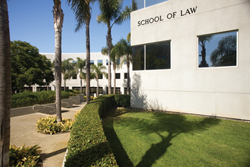
Photo by Max Dolberg
Chemerinsky’s colleagues say he is both efficient and impossibly polite. In an administrative meeting with staff, he moves through the agenda quickly. While others are discussing the merits, he is drafting a proposal that can be voted on and executed by meeting’s end. In an interview, he speaks in complete paragraphs. Um does not appear to be in his vocabulary.
In their nearby home, he and wife Catherine Fisk, who is a professor at the school, host dinner parties for faculty members and staff. Rumor has it that he’s an excellent chef, although he insists they cater gatherings larger than 10 guests. And Chemerinsky personally called each admitted student after his or her acceptance, but he notes, somewhat disappointed, that not all of them called back.
The schedule on his iPhone—a gift from Fisk—is packed from 7:30 a.m. through late evening most days with administrative meetings, conference calls with colleagues, and lunches with potential law school donors. It helps that he only sleeps four to six hours a night.
Its status as a public school doesn’t shield UC Irvine from the need to create an endowment. Its goal of raising $100 million in 10 years is part of a $1 billion university wide capital fundraising campaign. So far, the school has raised $28 million, including a recent $2 million anonymous grant for an Environmental Law Center. But $20 million of the total came from just one donor—Donald Bren, the billionaire chairman of the Irvine Co. real estate firm.
Fundraising is ahead of schedule, according to Charles Cannon, assistant dean of development and external affairs, who joined from the UCLA School of Law. UC Irvine already has funding for programs and clinics its founders thought they would have to wait another two years to develop, he says.
The startup has also attracted international support from the University of Cantabria in Santander, Spain, which will serve as a European arm of UC Irvine’s planned International Law & Business Institute.
Chemerinsky and Cannon also recently visited South Korea with the purpose of developing an Asian arm of the institute to promote solutions to conflicts between U.S. and Korean law. Though it is still in the planning stages, Chemerinsky envisions a future exchange of scholars, lawyers, judges and businesspeople in the two countries.
“There are a lot of new law schools popping up in Seoul, so they can relate to Irvine in a way they can’t connect to established U.S. schools,” Cannon explains.
Both programs will be supported by private donations, including those from foreign law firms, businesses and foundations.
Support is also strong for the law school in the Orange County community, which has lobbied the state university system for nearly 25 years for a law school. “The Orange County business community has been waiting for a school like this,” Chemerinsky says.
The county has a population of more than 3 million people, more than 14,000 of them attorneys. Public school UCLA (ranked 15th nationally by U.S. News & World Report) and private USC (ranked 18th) are 90 minutes north through Southern California’s stop-and-go traffic. The state’s other three public law schools—including sixth-ranked Berkeley—are near San Francisco, as is the private, third-ranked Stanford.
Yet most of the state’s growth since 1965, and much of its future expansion, is in Southern California. The region needs another top-tier school, says O’Melveny & Myers partner Brett Williamson, a former Chemerinsky student.
“There is a huge need in having an Orange County school with the resources and profile a UC school can bring,” says Williamson, who has practiced in Newport Beach for more than 20 years and now is managing partner of O’Melveny’s office there.
He says that every year, he sees more and more young lawyers who grew up in Orange County but went to law school out of state. “Then [they] try to come back here to practice,” Williamson says. “Now is absolutely the right time for this school.”
The 66-lawyer Newport Beach office is providing mentors and monetary support.
It is one of more than 70 Orange County businesses that have committed to conducting on-campus interviews at UC Irvine next fall, according to Ortiz.
A CHALLENGING ERA
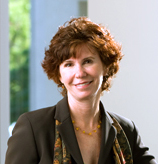
Carrie Hempel
Photo by Max Dolberg
Chemerinsky can use all the help he can get. His school is debuting amid record competition for law students and a recession the likes of which the legal profession hasn’t seen in more than 70 years.
There are now 200 ABA-accredited law schools nationwide. About 10 more have been in various stages of planning over the past year, but some of those have been tabled because of the recession’s impact.
And for a school that plans to rely on law firms to train students during term, as well as in the summers and after graduation, the recession could require a major change of plans. As of late June, almost 4,900 lawyers had been laid off by the nation’s major law firms since January 2008, according to the Law Shucks blog’s Layoff Tracker. Many associates in the classes of 2009 and 2010 have had their starting dates deferred, summer associate programs have been cut, and some big law firms have vowed to trim hiring for the foreseeable future.
Meanwhile, the state of California is facing a $24 billion budget deficit and is slashing higher-education expenditures in a bid to close the gap. In late June, as this magazine went to press, there was talk that UC Irvine faculty and staff might be facing pay cuts of up to 8 percent.
Despite the dour economic outlook, Chemerinsky remains sanguine about the school’s ability to persevere. “The chancellor has said in a number of speeches that even in a time of crisis, a family has to take care of its infants, and the law school is the infant of the university,” Chemerinsky says.
UC Irvine will be not just another school, but a different kind of school, he promises.
“I didn’t learn how to practice law in law school,” Chemerinsky says. He adds that speaking to practicing lawyers, judges and recent law school grads convinced him that things haven’t changed in the last 30 years.
“I want to prepare students for a changing profession,” he says. “I want to be sufficiently traditional to be credible and sufficiently innovative to justify why we exist.”



